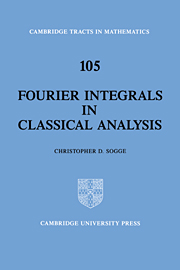Book contents
- Frontmatter
- Contents
- Preface
- 0 Background
- 1 Stationary Phase
- 2 Non-homogeneous Oscillatory Integral Operators
- 3 Pseudo-differential Operators
- 4 The Half-wave Operator and Functions of Pseudo-differential Operators
- 5 Lp Estimates of Eigenfunctions
- 6 Fourier Integral Operators
- 7 Local Smoothing of Fourier Integral Operators
- Appendix: Lagrangian Subspaces of T*IRn
- Bibliography
- Index
3 - Pseudo-differential Operators
Published online by Cambridge University Press: 15 September 2009
- Frontmatter
- Contents
- Preface
- 0 Background
- 1 Stationary Phase
- 2 Non-homogeneous Oscillatory Integral Operators
- 3 Pseudo-differential Operators
- 4 The Half-wave Operator and Functions of Pseudo-differential Operators
- 5 Lp Estimates of Eigenfunctions
- 6 Fourier Integral Operators
- 7 Local Smoothing of Fourier Integral Operators
- Appendix: Lagrangian Subspaces of T*IRn
- Bibliography
- Index
Summary
The rest of this course will mainly be concerned with “variable coefficient Fourier analysis”—that is, finding natural variable coefficient versions of the restriction theorem, and so forth. One of our ultimate goals will be to extend these results to the setting of eigenfunction expansions given by the spectral decomposition of a self-adjoint pseudo-differential operator. To state the results, however, and to develop the necessary tools for their study, we need to go over some of the main elements in the theory of pseudo-differential operators. These will be given in Section 1 and our presentation will be a bit sketchy but essentially self-contained. For a more thorough treatment, we refer the reader to the books of Hörmander [7], Taylor [2], and Treves [1]. In Section 2 we present the equivalence of phase function theorem for pseudo-differential operators. This will play an important role in the parametrix construction for the (variable coefficient) half-wave operator. Finally, in Section 3, we present background needed for the study of Fourier analysis on manifolds, such as basic facts about the spectral function. We also present a theorem of Seeley on powers of elliptic differential operators which allows one to reduce questions about the Fourier analysis of higher order elliptic operators to questions about first order operators.
Some Basics
We start out by defining pseudo-differential operators on ℝn.
- Type
- Chapter
- Information
- Fourier Integrals in Classical Analysis , pp. 93 - 112Publisher: Cambridge University PressPrint publication year: 1993



